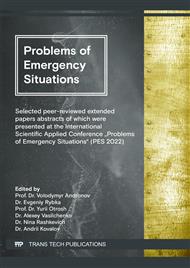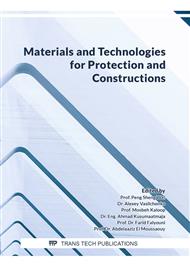[1]
A.I. Abdullin, E.A Emelyanycheva, A study of properties of road Petroleum bitumen modified with polymer additives, Journal of Chemical Technology and Metallurgy. 53(3) (2018) 422–429.
Google Scholar
[2]
A.A. Al-Rabiah, O.Y. Abdelaziz, E.M. Montero, M.S. Aazam, Effect of styrenebutadiene-styrene copolymer modification on properties of Saudi bitumen, Pet. Sci. Technol. 34 (2016) 321–327.
DOI: 10.1080/10916466.2015.1129345
Google Scholar
[3]
Y. Kumar, S.K. Singh, D. Oberoi, P. Kumar, P. Mohanty, S.S. Ravindranath, Effect of molecular structure and concentration of styrene-butadiene polymer on upper service temperature rheological properties of modified binders, Constr. Build. Mater. 249 (2020) 118790.
DOI: 10.1016/j.conbuildmat.2020.118790
Google Scholar
[4]
D. Ayupov, Y. Khakimullin, R.Kazakulov, Bitumen chemical modification by a thermoplastic polymer, IOP Conference Series: Materials Science and Engineering. 890 (2020) 012094.
DOI: 10.1088/1757-899x/890/1/012094
Google Scholar
[5]
Y. Xingyu, C. Huimin, W. Houzhi, S. Chenguang , Y. Jun, The feasibility of using epoxy asphalt to recycle a mixture containing 100% reclaimed asphalt pavement (RAP), Construction and Building Materials. 319 (2022) 126122. https://doi.org/10.1016/j.conbuildmat.2021.126122.
DOI: 10.1016/j.conbuildmat.2021.126122
Google Scholar
[6]
E.S. Okhotnikova, Y.M. Ganeeva, I.N. Frolov, M.A. Ziganshin, A.A. Firsin, A.H. Timirgalieva, T.N. Yusupova, Thermal and structural characterization of bitumen by modulated differential scanning calorimetry, Journal of thermal analysis and calorimetry. 142 (1) (2020) 211–216.
DOI: 10.1007/s10973-020-09772-y
Google Scholar
[7]
І.O. Lavrova, S.І. Buhkalo, S.V. Valujkіn, Analіz mozhlivostej vikoristannya fosfolіpіdіv dlya pіdvishchennya adgezіjnoї zdatnostі dorozhnіh bіtumіv,Vіsnik NTU «HPІ». 5 (1359) (2020) 71–78.
Google Scholar
[8]
A. Cherkashina, I. Lavrova, V. Lebedev, Development of a bitumen-polymer composition, resistant to atmospheric influences, based on petroleum bitumen and their properties study, Materials Science Forum. 1038 (2021) 352–8. https://doi.org/10.4028/www.scientific.net/msf.1038.352.
DOI: 10.4028/www.scientific.net/msf.1038.352
Google Scholar
[9]
M. Jamal, G. Martinez-Arguelles, F. Giustozzi, Effect of waste tyre rubber size on physical, rheological and UV resistance of high-content rubber-modified bitumen, Construction and Building Materials. 304 (2021) 124638. https://doi.org/10.1016/j.conbuildmat.2021.124638.
DOI: 10.1016/j.conbuildmat.2021.124638
Google Scholar
[10]
S. Nizamuddin, Y.J. Boom, F. Giustozzi, Sustainable Polymers from Recycled Waste Plastics and Their Virgin Counterparts as Bitumen Modifiers: A Comprehensive Review, Polymers 13 (2021) 3242. https://doi.org/10.3390/polym13193242.
DOI: 10.3390/polym13193242
Google Scholar
[11]
S. Marini, M. Lanotte, Waste Rubber from End-of-Life Tires in Lean, Asphalt Mixtures-A Laboratory and Field Investigation in the Arid Climate Region, Polymers. 13(21) (2021) 3802.
DOI: 10.3390/polym13213802
Google Scholar



